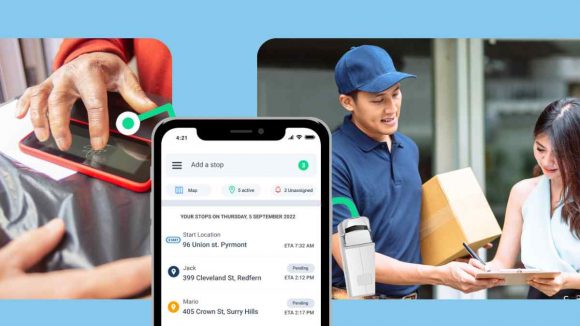Proof of delivery (PoD) has transformed from a simple acknowledgment of receipt into a sophisticated business tool.
It’s like a track record for all your deliveries, and at the same time, it boosts transparency and customer satisfaction.
Technology constantly evolves, and 2025 is expected to shift consumer behavior into a new gear.
Let’s explore the top eight trends shaping the future of proof of delivery.
What is Proof of Delivery?
Proof of delivery is a formal, often documented acknowledgment that goods or services have been successfully delivered to the intended recipient.
It’s like a digital footprint of all the delivery information gathered for each stop. Instead of having thousands of paper documents, delivery documents contain all the information needed to form a legal document in case of a customer dispute.
It also records delivery drivers’ performance. PoD works seamlessly with your delivery management software to track driver performance and check on delivery drivers’ productivity.
Traditionally, delivery companies had to collect delivery documents manually. This included signatures and written information about the transaction.
Nowadays, modern PoD systems utilize digital signatures, photos, and GPS tracking. They contain delivery details that improve accuracy, reduce disputes, and streamline supply chain processes.

1. Integration of Real-Time Tracking and Proof of Delivery
By late 2025, real-time tracking will be crucial in proof of delivery systems.
Imagine a customer ordering a new smartphone online. With real-time tracking, the customer can watch exactly as the delivery vehicle approaches the address. When the driver delivers the package, they scan it or take a quick photo as proof of delivery (PoD).
The customer and business immediately receive a notification confirming that the expensive device has been delivered, along with the exact time and location. If the person tries to dispute the delivery later, the delivery document serves as proof.
This technology ensures customers can trust your brand and be part of the transparent delivery process.
2. AI-Powered Automation
Artificial intelligence (AI) is making PoD smarter. These days, AI can analyze delivery patterns, optimize routes, and predict potential delays.
This is a smart way to automate systems and avoid human error. We’ve all seen those blurry PoD photos, but with AI, this can be the past.
Expect AI to become even more integral to PoD systems in 2025, where drivers get notifications and alerts to improve the picture proof.
3. Blockchain for Immutable Records
Blockchain technology is emerging as a solution for secure and tamper-proof PoD records.
Customers used to physical document proof might be skeptical about the security of their information captured as digital proof.
Blockchain is like a super-secure online notebook where no one can change the entries. It ensures proof of delivery records can’t be faked or tampered with for deliveries.
This is especially important for expensive items or medicines, where accuracy and trust are critical.
4. Contactless Delivery Solutions
You thought contactless delivery was only something customers wanted during the pandemic era. Wrong, it’s here to stay.
Expect innovative solutions like facial recognition, QR codes, and voice confirmations to become standard in PoD systems by 2025.
Having to take out a pen, take the customer’s physical signature, take a photo and go back to the office to make a manual entry, is time consuming.
With new technology like facial recognition, voice confirmations, and QR codes, it’s safer for customers and more hygienic.

5. Biometric Signatures
Biometric authentication is taking proof of delivery to a whole new level.
Think about fingerprint scans, facial recognition, and even iris scans. These are replacing traditional signatures and improving customers’ delivery experiences.
You need the right software for this advanced technology, which can save time and allow drivers to make more daily deliveries.
In the world of AI, where customers are worried about their cyber safety, these methods enhance security and make PoD more efficient, especially for sensitive deliveries.
6. Enhanced Mobile Proof of Delivery Applications
Mobile apps are used by modern delivery companies to provide proof of delivery systems.
These apps provide drivers with all the tools needed to complete deliveries, from capturing electronic signatures to taking photos as evidence. Every driver has a mobile phone, making it extremely convenient to capture all the necessary information in a few seconds.
By 2025, expect mobile PoD applications to offer advanced analytics, real-time updates, and offline functionality for areas with poor connectivity.
7. Drones and Autonomous Vehicles in Proof of Delivery
You might wonder, with Amazon and Walmart increasing drone deliveries by 2025, where PoD fits in.
Drones and electric vehicles are reshaping logistics operations. These technologies are expected to significantly impact PoD by providing precise delivery confirmations.
Drones will use integrated cameras, GPS data, and automated systems to capture PoD. This trend is particularly relevant for remote areas and same-day delivery services.
8. Multi-Layered Security in PoD Systems
As we welcome more digital-driven PoD in logistics, it also comes with cybersecurity concerns.
By 2025, companies will adopt multi-layered security measures, including end-to-end encryption and secure cloud storage, to protect sensitive delivery data. It’s almost non-negotiable if you want to make sure customers trust your brand.
Trustworthy PoD systems will be a key differentiator in competitive markets.
How to Prepare for the Future of PoD
To stay ahead of these trends, businesses should invest in technology upgrades, including AI and blockchain.
Prioritizing customer-centric features like real-time updates and photo proofs will set your business apart and keep you up with the latest logistics.
About the author
Mia is a multi-award-winning journalist. She has more than 14 years of experience in mainstream media. She's covered many historic moments that happened in Africa and internationally. She has a strong focus on human interest stories, to bring her readers and viewers closer to the topics at hand.











